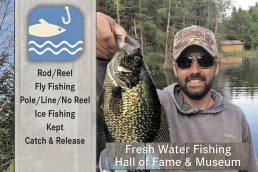World Records Within Reach
SHARE THIS POST
If you’ve ever dreamt of holding a world record, when it comes to freshwater fishing, Tom Berg says that dream may be well within reach.
Have you ever caught a world-record fish? Chances are that you haven’t. Odds are pretty good, however, that you could. New world-record fish are being caught all the time, and it’s not all pure luck. Many of the most successful anglers are targeting specific fish and setting world records on purpose.
You can do it, too. Setting a world record is easier than you might think. Here’s what you need to do.
One of the problems faced by most first-time record-seekers is that they have no idea where to start in their quest for a world record. Information is the key, so go directly to the source. The National Fresh Water Fishing Hall of Fame in Hayward, Wisconsin is the official organization that qualifies and recognizes freshwater world-record fish.
Every year, “The Hall” publishes the latest official records book which lists every current world-record fish on file. The records are subdivided into various line-classes, and the largest fish of a species taken on any size line is listed as the “All-Tackle” record. Although the All-Tackle record is typically a giant fish that is extremely difficult to exceed, the line-class records offer a much easier route to a world record (6-pound-test line class, 8-pound-test line class, etc).
For example, Ohio River catfish anglers in search of a flathead catfish record might be intimidated by the all-tackle world record of 123 pounds, and for good reason! But, a quick glance through the most recent record book reveals that the 36-pound-test line-class record is a fish that weighed 33 pounds, 0 ounces. While a flathead of that size is still considered a trophy, it is certainly beatable by anglers who target big flatheads on a productive river like the Ohio on a regular basis.
Better yet, target a line-class record that has not yet been filled! A further review of the record book for flathead catfish shows that the line class record for 70-pound-test line is open! That means that the first angler who catches a flathead on 70-pound-test line (there is a 1-pound minimum size for all species) will be awarded the world record! Of course, you must follow all the rules and file the required paperwork, but when that is done, you will be a world record holder!
One of the main reasons that the flathead catfish 70-pound-test line-class record has not been set yet is that very few people (and fewer catfish anglers) routinely spool-up with 70-pound-test line. But you certainly could, especially if you were interested in setting a new flathead catfish world record! Of course, 70-pound-test line isn’t very common at the local tackle shop, so you would have to order that line specifically if you wanted to set that record.
Are you enjoying this post?
You can be among the first to get the latest info on where to go, what to use and how to use it!
So, the first step in the record-quest is to contact the Hall of Fame in Hayward and get a copy of the records book. The current cost of the record book is $15, but it is free to members of the Hall (annual memberships start at $30). Determine which line-class records are attainable for the species that you fish for and use the appropriate strength line for that line class. Believe it or not, there are still quite a few line classes for certain species that are open. After you have done your homework, all you have to do is catch a big fish!
Once you catch a qualifying fish on the proper size line, you must get the fish weighed on a certified scale (such as those at grocery stores, post offices, etc). Weigh the fish only once, in the presence of two disinterested witnesses. There are even catch-and-release world records, and those fish only need to be measured. Measure the fish and have the witnesses sign your record application (photocopied from the record book or available free from the Hall). You will also need to get the form notarized.
Take some good photos of the fish, since a clear photo is required with the application. Save the first 25 feet of line nearest the hook/lure and submit it for line testing purposes, too. After all, the breaking strength of your line must fall into the proper line class to set a new record. Keep the line untangled by winding it on a piece of notched cardboard. Fill out the rest of the application and mail it in! Applications must be received within 90 days of the catch.
Fishing for many of the most popular species of fish in the Midwest has never been better. Get out there and set a few records of your own. Don’t wait too long, though, or someone will beat you to it. Maybe it will be me.
For more information…
or World Record application forms, contact the National Fresh Water Fishing Hall of Fame at P.O. Box 690, 10360 Hall of Fame Drive, Hayward, WI 54843; phone (715) 634-4440; email: fishhall@cheqnet.net. Check out their website at Freshwater-Fishing.org.
Whether you’re looking to fish competitively or just for relaxation and recreation, you’ll find plenty of helpful fishing insight in every issue of MidWest Outdoors, available by subscribing on our website.
MWO
SHARE THIS POST
You may also like...
Nothing found.
Did you enjoy this post?
You can be among the first to get the latest info on where to go, what to use and how to use it!
Tom Berg
A lifelong outdoorsman and award-winning outdoor writer and nature photographer, Tom Berg has been the Executive Director/Treasurer of the Hoosier Outdoor Writers group for the past 14 years. When he is not writing, he would rather be outside fishing, hunting or trapping than doing just about anything else.
